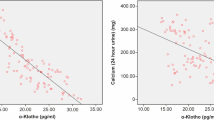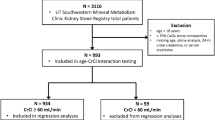Abstract
Association of increased oxidative stress (OS) with the pathophysiology of renal stone formation has not been explored greatly in the field of urolithiasis. In this prospective case–control study, we measured 24-h urinary 8-hydroxy-2’-deoxyguanosine (8-OHdG) levels in patients with urolithiasis and compared them with matched healthy controls. We also measured 24-h urinary uric acid, calcium, oxalate, and citrate levels in patients with renal stone disease and studied their relation with urinary 8-OHdG levels. Seventy-five cases of renal stone disease and 75 well-matched controls were included. Median 24-h urinary 8-OHdG levels were significantly higher in cases compared to controls (7.6 vs. 3.7 µg/g of creatinine; p < 0.000). Receiver-operating curve (ROC) analysis for 8-OHdG between cases and controls revealed an area under the curve of 0.90. At 8-OHdG (µg/g of creatinine) value of 5 or more, a sensitivity and a specificity of 84% each were obtained. A positive correlation between 8-OHdG (µg/g of creatinine) and 24-h urinary oxalate level was noted (r = 0.461, p = 0.000). No correlation between 8-OHdG (µg/g of creatinine) and other variables was noted. On multivariate linear regression analysis, we noted 24-h urinary oxalate levels to be an independent predictor of urinary 8-OHdG levels. OS is significantly higher in patients with renal stone diseases compared to healthy controls. Urinary oxalate levels were significantly correlated with urinary 8-OHdG levels.


Similar content being viewed by others
Data availability
The basic study data of the current study will be made available to the journal only after proper consent from the Institute, where the study was conducted.
References
Scales CD Jr, Smith AC, Hanley JM et al (2012) Prevalence of kidney stones in the United States. Eur Urol 62:160–165
Randall A (1937) The origin and growth of renal calculi. Ann Surg 105:1009–1027
Evan A, Lingeman J, Coe FL et al (2006) Randall’s plaque: pathogenesis and role in calcium oxalate nephrolithiasis. Kidney Int 69:1313–1318
Khan SR (2012) Is oxidative stress, a link between nephrolithiasis and obesity, hypertension, diabetes, chronic kidney disease, metabolic syndrome? Urol Res 40:95–112
Cappuccio FP, Siani A, Barba G et al (1999) A prospective study of hypertension and the incidence of kidney stones in men. J Hypertens 17:1017–1022
Taylor EN, Stampfer MJ, Curhan GC (2005) Diabetes mellitus and the risk of nephrolithiasis. Kidney Int 68:1230–1235
Taylor EN, Stampfer MJ, Curhan GC (2005) Obesity, weight gain, and the risk of kidney stones. JAMA 293:455–462
Alexander RT, Hemmelgarn BR, Wiebe N et al (2014) Kidney stones and cardiovascular events: a cohort study. Clin J Am Soc Nephrol 9:506–512
Jeong IG, Kang T, Bang JK et al (2011) Association between metabolic syndrome and the presence of kidney stones in a screened population. Am J Kidney Dis 58:383–388
Baggio B, Gambaro G, Ossi E et al (1983) Increased urinary excretion of renal enzymes in idiopathic calcium oxalate nephrolithiasis. J Urol 129:1161–1162
Khan SR (2013) Reactive oxygen species as the molecular modulators of calcium oxalate kidney stone formation: evidence from clinical and experimental investigations. J Urol 189:803–811
Cooke MS, Evans MD, Dove R et al (2005) DNA repair is responsible for the presence of oxidatively damaged DNA lesions in urine. Mutat Res 574:58–66
Youden WJ (1950) Index for rating diagnostic tests. Cancer 3:32–35
Boonla C, Wunsuwan R, Tungsanga K et al (2007) Urinary 8-hydroxydeoxyguanosine is elevated in patients with nephrolithiasis. Urol Res 35:185–191
Hakim IA, Harris RB, Brown S et al (2003) Effect of increased tea consumption on oxidative DNA damage among smokers: a randomized controlled study. J Nutr 133:3303S-S3309
Kittikowit W, Waiwijit U, Boonla C et al (2014) Increased oxidative DNA damage seen in renal biopsies adjacent stones in patients with nephrolithiasis. Urolithiasis 42:387–394
Khan SR (2004) Crystal-induced inflammation of the kidneys: results from human studies, animal models, and tissue-culture studies. Clin Exp Nephrol 8:75–88
Rashed T, Menon M, Thamilselvan S (2004) Molecular mechanism of oxalate-induced free radical production and glutathione redox imbalance in renal epithelial cells: effect of antioxidants. Am J Nephrol 24:557–568
Aydin H, Yencilek F, Mutlu N et al (2010) Ethylene glycol induced hyperoxaluria increases plasma and renal tissue asymmetrical dimethylarginine in rats: a new pathogenetic link in hyperoxaluria induced disorders. J Urol 183:759–764
Hanna IR, Taniyama Y, Szocs K et al (2002) NAD(P)H oxidase-derived reactive oxygen species as mediators of angiotensin II signaling. Antioxid Redox Signal 4:899–914
Toblli JE, Ferder L, Stella I et al (2002) Effects of angiotensin II subtype 1 receptor blockade by losartan on tubulointerstitial lesions caused by hyperoxaluria. J Urol 168:1550–1555
Barregard L, Moller P, Henriksen T et al (2013) Human and methodological sources of variability in the measurement of urinary 8-oxo-7,8-dihydro-2’-deoxyguanosine. Antioxid Redox Signal 18:2377–2391
Funding
This study was financially supported by Post Graduate Institute of Medical Education and Research, Chandigarh, India.
Author information
Authors and Affiliations
Contributions
Manoharan V involved in protocol development, data collection and management, data analysis, and manuscript writing. Sharma G involved in data collection and management, data analysis, and manuscript writing. Devana SK involved in data collection and management, data analysis, and manuscript writing. Sharma S involved in data collection and management and manuscript editing. Avti P involved in manuscript writing and editing. Sivaraman C involved in data collection and management and manuscript editing.
Corresponding author
Ethics declarations
Conflict of interest
The authors declare that they have no conflict of interest.
Statement of human rights
This research involved human participants, and the study protocol was approved by the institute’s ethics committee (Ref: INT/IEC/2017/1396). We certify that the study was performed in accordance with the ethical standards as laid down in the 1964 Declaration of Helsinki and its later amendments or comparable ethical standards.
Statement on the welfare of animals
This article does not contain any studies with animals performed by any of the authors.
Informed consent
Informed consent was obtained from all individual participants included in the study.
Additional information
Publisher's Note
Springer Nature remains neutral with regard to jurisdictional claims in published maps and institutional affiliations.
Supplementary Information
Below is the link to the electronic supplementary material.
Rights and permissions
Springer Nature or its licensor (e.g. a society or other partner) holds exclusive rights to this article under a publishing agreement with the author(s) or other rightsholder(s); author self-archiving of the accepted manuscript version of this article is solely governed by the terms of such publishing agreement and applicable law.
About this article
Cite this article
Manoharan, V., Sharma, G., Devana, S.K. et al. A prospective case–control study on the evaluation of oxidative stress in renal stone formers. Urolithiasis 52, 18 (2024). https://doi.org/10.1007/s00240-023-01514-7
Received:
Accepted:
Published:
DOI: https://doi.org/10.1007/s00240-023-01514-7




